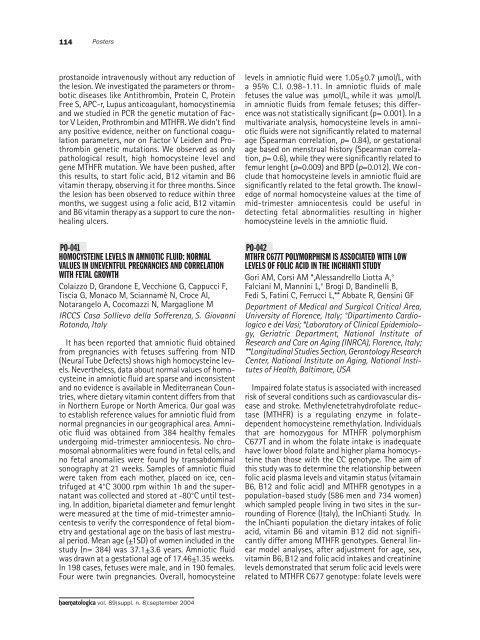Haematologica 2004;89: supplement no. 8 - Supplements ...
Haematologica 2004;89: supplement no. 8 - Supplements ...
Haematologica 2004;89: supplement no. 8 - Supplements ...
- No tags were found...
Create successful ePaper yourself
Turn your PDF publications into a flip-book with our unique Google optimized e-Paper software.
114Postersprosta<strong>no</strong>ide intrave<strong>no</strong>usly without any reduction ofthe lesion. We investigated the parameters or thromboticdiseases like Antithrombin, Protein C, ProteinFree S, APC-r, Lupus anticoagulant, homocystinemiaand we studied in PCR the genetic mutation of FactorV Leiden, Prothrombin and MTHFR. We didn’t findany positive evidence, neither on functional coagulationparameters, <strong>no</strong>r on Factor V Leiden and Prothrombingenetic mutations. We observed as onlypathological result, high homocysteine level andgene MTHFR mutation. We have been pushed, afterthis results, to start folic acid, B12 vitamin and B6vitamin therapy, observing it for three months. Sincethe lesion has been observed to reduce within threemonths, we suggest using a folic acid, B12 vitaminand B6 vitamin therapy as a support to cure the <strong>no</strong>nhealingulcers.levels in amniotic fluid were 1.05±0.7 µmol/L, witha 95% C.I. 0.98-1.11. In amniotic fluids of malefetuses the value was µmol/L, while it was µmol/Lin amniotic fluids from female fetuses; this differencewas <strong>no</strong>t statistically significant (p= 0.001). In amultivariate analysis, homocysteine levels in amnioticfluids were <strong>no</strong>t significantly related to maternalage (Spearman correlation, p= 0.84), or gestationalage based on menstrual history (Spearman correlation,p= 0.6), while they were significantly related tofemur lenght (p=0.009) and BPD (p=0.012). We concludethat homocysteine levels in amniotic fluid aresignificantly related to the fetal growth. The k<strong>no</strong>wledgeof <strong>no</strong>rmal homocysteine values at the time ofmid-trimester amniocentesis could be useful indetecting fetal ab<strong>no</strong>rmalities resulting in higherhomocysteine levels in the amniotic fluid.PO-041HOMOCYSTEINE LEVELS IN AMNIOTIC FLUID: NORMALVALUES IN UNEVENTFUL PREGNANCIES AND CORRELATIONWITH FETAL GROWTHColaizzo D, Grandone E, Vecchione G, Cappucci F,Tiscia G, Monaco M, Sciannamè N, Croce AI,Notarangelo A, Cocomazzi N, Margaglione MIRCCS Casa Sollievo della Sofferenza, S. GiovanniRotondo, ItalyIt has been reported that amniotic fluid obtainedfrom pregnancies with fetuses suffering from NTD(Neural Tube Defects) shows high homocysteine levels.Nevertheless, data about <strong>no</strong>rmal values of homocysteinein amniotic fluid are sparse and inconsistentand <strong>no</strong> evidence is available in Mediterranean Countries,where dietary vitamin content differs from thatin Northern Europe or North America. Our goal wasto establish reference values for amniotic fluid from<strong>no</strong>rmal pregnancies in our geographical area. Amnioticfluid was obtained from 384 healthy femalesundergoing mid-trimester amniocentesis. No chromosomalab<strong>no</strong>rmalities were found in fetal cells, and<strong>no</strong> fetal a<strong>no</strong>malies were found by transabdominalso<strong>no</strong>graphy at 21 weeks. Samples of amniotic fluidwere taken from each mother, placed on ice, centrifugedat 4°C 3000 rpm within 1h and the supernatantwas collected and stored at -80°C until testing.In addition, biparietal diameter and femur lenghtwere measured at the time of mid-trimester amniocentesisto verify the correspondence of fetal biometryand gestational age on the basis of last mestrualperiod. Mean age (±1SD) of women included in thestudy (n= 384) was 37.1±3.6 years. Amniotic fluidwas drawn at a gestational age of 17.46±1.35 weeks.In 198 cases, fetuses were male, and in 190 females.Four were twin pregnancies. Overall, homocysteinePO-042MTHFR C677T POLYMORPHISM IS ASSOCIATED WITH LOWLEVELS OF FOLIC ACID IN THE INCHIANTI STUDYGori AM, Corsi AM *,Alessandrello Liotta A,°Falciani M, Mannini L,° Brogi D, Bandinelli B,Fedi S, Fatini C, Ferrucci L,** Abbate R, Gensini GFDepartment of Medical and Surgical Critical Area,University of Florence, Italy; °Dipartimento Cardiologicoe dei Vasi; *Laboratory of Clinical Epidemiology,Geriatric Department, National Institute ofResearch and Care on Aging (INRCA), Florence, Italy;**Longitudinal Studies Section, Gerontology ResearchCenter, National Institute on Aging, National Institutesof Health, Baltimore, USAImpaired folate status is associated with increasedrisk of several conditions such as cardiovascular diseaseand stroke. Methylenetetrahydrofolate reductase(MTHFR) is a regulating enzyme in folatedependenthomocysteine remethylation. Individualsthat are homozygous for MTHFR polymorphismC677T and in whom the folate intake is inadequatehave lower blood folate and higher plama homocysteinethan those with the CC ge<strong>no</strong>type. The aim ofthis study was to determine the relationship betweenfolic acid plasma levels and vitamin status (vitamainB6, B12 and folic acid) and MTHFR ge<strong>no</strong>types in apopulation-based study (586 men and 734 women)which sampled people living in two sites in the surroundingof Florence (Italy), the InChianti Study. Inthe InChianti population the dietary intakes of folicacid, vitamin B6 and vitamin B12 did <strong>no</strong>t significantlydiffer among MTHFR ge<strong>no</strong>types. General linearmodel analyses, after adjustment for age, sex,vitamin B6, B12 and folic acid intakes and creatininelevels demonstrated that serum folic acid levels wererelated to MTHFR C677 ge<strong>no</strong>type: folate levels werehaematologica vol. <strong>89</strong>(suppl. n. 8):september <strong>2004</strong>
















